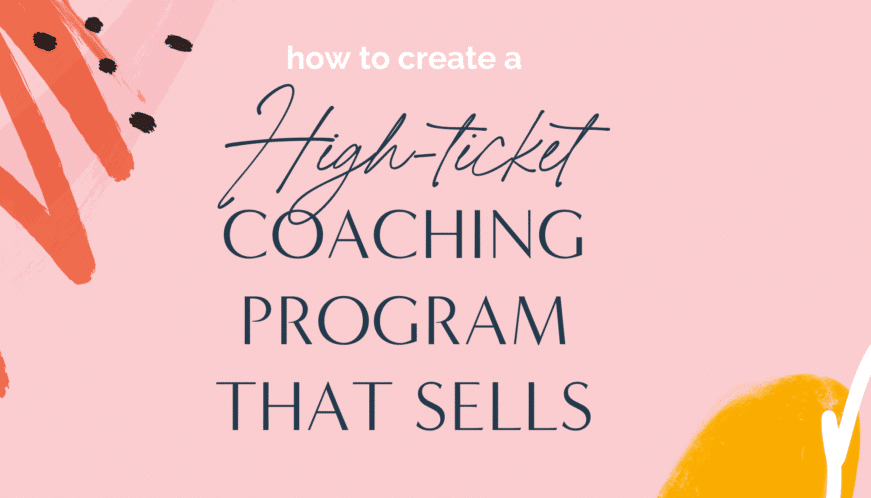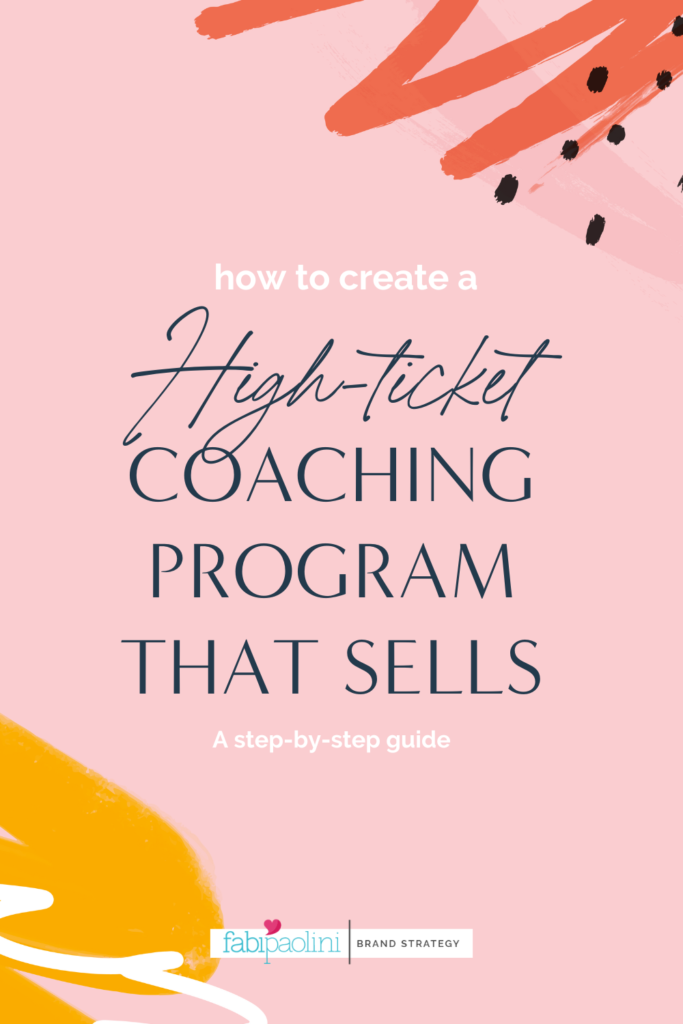
The Ultimate Guide to High Ticket Coaching: How to Build a Thriving Coaching Business
Are you a coach or consultant looking to take your online business to the next level? Are you struggling to attract your ideal clients or find the best way to monetize your coaching skills? If so, you’re not alone. Many coaches and consultants face the challenge of creating a sustainable and profitable business that provides high-value coaching services to its target audience. One of the most effective solutions to this problem is creating a high-ticket coaching program.
Offering a high-ticket program with a high price point can attract new clients who are willing to invest in themselves and their success, and can help you generate significant revenue in your online coaching business.
In this blog post, we’ll provide you with a guide on how to create a high-ticket coaching program that sells.
We’ll share proven strategies and best practices that successful business coaches have used to create high-ticket programs and attract their dream clients. So, whether you’re a seasoned coach or just starting out in the coaching industry, this blog post will help you take your coaching business to the next level and achieve your goals.
Let’s dive in and discover the best practices for creating a high-ticket coaching program that will help you attract high-paying clients and generate significant revenue for your online coaching business.
I created a short training that walks you through the 3 secrets to attracting ready-to-invest, premium coaching clients while making weekly, high-ticket sales.
Make sure you check it out below:
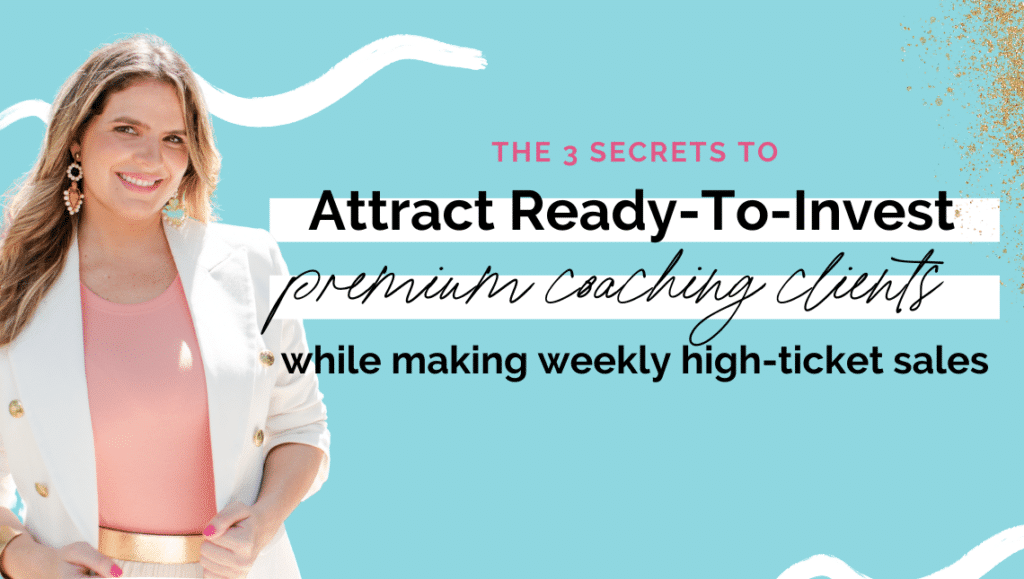
Why Low-Priced Coaching Programs Are Holding You Back From Success
Creating a successful coaching business is not an easy task. You need to identify your ideal client, create online courses, and develop a high-ticket offer to attract potential clients. Also, navigate the world of social media, sales calls, and credit card transactions to increase your conversion rate and revenue.
Finding the right business model, attracting your first clients, and eventually securing high-ticket clients takes time and money.
Even when you find a good fit and attract your first clients, the first months can be challenging.
Creating a high-ticket offer as a course creator or developing a coaching package to get better results requires a lot of effort and patience.
Selling a high-ticket program and closing high-ticket sales takes a long time. It can be hard to know the right way to do it.
Managing team members and ensuring that your business is always in the right place takes a lot of time and effort. Especially if you’re running your coaching business full-time.
Creating a great landing page and ensuring a high close rate for your high-ticket program is also essential. As the price tag is often higher than industry standards, it can be challenging to balance offering low-ticket courses for lower-level clients while also catering to higher levels with a high-ticket model.
Give Value and you Shall Receive Value
As a coach or consultant, you may struggle to determine the best way to meet your client’s needs, attract the right people, and sell a high-ticket program successfully.
You may also have a hard time finding the right mindset to keep pushing forward, especially in the first few months of your business. Building a successful coaching business requires a lot of high-quality work, direct access to your only product, and owning your own high ticket to make a bigger impact.
However, the good news is that with the right strategies, coaches can create a successful business that attracts their dream clients and generates much money at the end of the day.
In the next section, we’ll discuss how to solve the problems of creating a high-ticket program and building a successful coaching business.
Unlocking Success with High Ticket Coaching Programs: A Step-by-Step Guide
Creating a high-ticket coaching program is the solution to your problems. It will help you attract high-paying clients, generate significant revenue, and take your coaching business to the next level.
The benefits of a high-ticket coaching program are many. The ability to work with ideal clients who are committed to getting results, earning more money per client, and having a bigger impact on people’s lives.
By offering a high-ticket program, you can position yourself as an expert in your field and build a successful and sustainable coaching business.
Step 1: Identify Your Target Audience
Identifying your target audience is the first step in creating a successful high-ticket coaching program.
To do this effectively, you need to know your ideal client and what their specific needs and pain points are. This will help you tailor your coaching program to their specific needs and make sure that you are providing them with the best possible value.
When defining your ideal client, it’s important to consider their age, gender, occupation, income level, interests, and goals.
You should also consider what their specific pain points are and how your program can help them overcome those challenges. For example, if you’re a life coach, your ideal client might be a busy professional who is struggling to balance their work and personal life.
To identify your target audience, you can start by looking at your existing clients and analyzing their characteristics and needs.
You can also conduct market research to identify trends and patterns in your industry. Determine what types of clients are most in need of your services.
Once you’ve identified your target audience, you can start tailoring your coaching program to their specific needs and pain points.
This might involve developing specific coaching exercises, tools, and resources that are designed to help your clients overcome their challenges and achieve their goals.
By providing value that is specifically tailored to your target audience, you can increase the likelihood that they will see the benefits of your coaching program and be willing to invest in it at a high-ticket price point.
Here is some more advice on How to Choose Your Ideal Client?
Step 2: Define Your Coaching Niche
Defining your coaching niche is an essential step in creating a high-ticket coaching program.
Your niche will determine the area of expertise that you will focus on and the unique value you can offer.
By identifying your niche, you can create a coaching program that addresses your client’s needs in that area where you are an expert.
To define your coaching niche, start by identifying the specific area of expertise within your industry that you are passionate about and have experience in.
Consider your skills, knowledge, and experience in your field, as well as your personal interests and strengths. Next, research the needs and pain points of your target audience within that specific area of expertise.
Conduct market research, analyze industry trends, and gather feedback from potential clients. That is to gain insights into the challenges they face and the solutions they need.
Based on your research, develop a coaching program that addresses your client’s specific needs and pain points. This could include developing a signature coaching methodology, creating a unique coaching framework, or offering specialized coaching packages tailored to the needs of your target audience.
By defining your coaching niche, you can position yourself as an expert in a specific area. Also, differentiate yourself from other coaches, and create a coaching program that meets the specific needs of your target audience.
This will help you attract high-paying clients who are willing to invest in your services and create a successful and sustainable coaching business.
Here are some ideas on High Ticket Coaching Niches.
Step 3: Develop Your Coaching Methodology and Framework
Developing a coaching methodology and framework is crucial to create a high-ticket coaching program that delivers value and results.
A unique methodology can set you apart from other coaches and help you attract clients who are looking for a specific approach to solving their problems.
To develop your coaching methodology and framework, you should start by analyzing your own experience and expertise. What methods have worked best for you in the past? What strategies do you use to help your clients achieve their goals? Consider the problems your target audience faces and what they need to achieve success.
Next, you can start to develop your coaching framework. This is a system of steps or phases that you guide your clients through to achieve their desired outcomes.
Your framework should be easy to understand and follow and should be adaptable to the unique needs of each client. It’s also important to continually refine and improve your coaching methodology and framework based on feedback from your clients. By asking for feedback, you can better understand your client’s needs and improve your coaching program to better serve them.
Overall, developing a unique coaching methodology and framework is a key component of creating a successful high-ticket coaching program.
By focusing on delivering results and creating a system that sets you apart from other coaches, you can build a strong reputation and attract clients who are willing to invest in themselves.
Step 4: Price Your Coaching Program Appropriately
Pricing your coaching program appropriately is a crucial step in creating a successful high-ticket coaching program.
You want to make sure that your price reflects the value of your program while being affordable for your target audience.
To determine the right price point for your program, you first need to understand the value that you are providing.
Consider the results that your coaching program can help your clients achieve; the time and effort that you are putting into creating and delivering the program, and the expertise and experience that you bring to the table.
Next, research your market and your target audience to determine what they are willing to pay for your coaching program. Look at what other coaches in your niche are charging for similar programs. Survey your potential clients to understand their budget and what they would be willing to pay for your program.
Finally, test your price point with a small group of clients to see how they respond. If you are not getting enough sign-ups, consider adjusting your price point or your marketing strategy.
Remember that pricing is not just about the dollar amount – it’s also about the perceived value of your coaching program.
Make sure that your price is communicated clearly and confidently on your sales page. Emphasize the benefits and results that clients can expect from working with you.
Step 5: Create a Sales Page that Converts
Creating a sales page that converts is an essential aspect of a successful high-ticket coaching program.
A sales page is a webpage that serves as the primary platform for promoting and selling your coaching program.
It should communicate the benefits of your coaching program and persuade potential clients to sign up for your services.
Here are some tips for creating a sales page that converts:
Clearly communicate the benefits
Your sales page should communicate the benefits of your coaching program and how it can help your clients achieve their goals. Use clear and concise language to explain how your coaching program addresses their specific needs and pain points.
Use persuasive language
Your sales page should use persuasive language to persuade potential clients to sign up for your coaching program. Use action-oriented language and emphasize the transformation your coaching program can bring to their lives.
Include social proof
Social proof, such as testimonials from past clients, can help build trust and credibility with potential clients. Include testimonials on your sales page to demonstrate the effectiveness of your coaching program.
Use compelling visuals
Visuals, such as images and videos, can help break up the text on your sales page and make it more engaging. Use high-quality visuals that are relevant to your coaching program and target audience.
This is an example of what a compelling visual looks like. Katie is a client who works with people to help them overcome binge eating. This is what her brand and message looked like before;
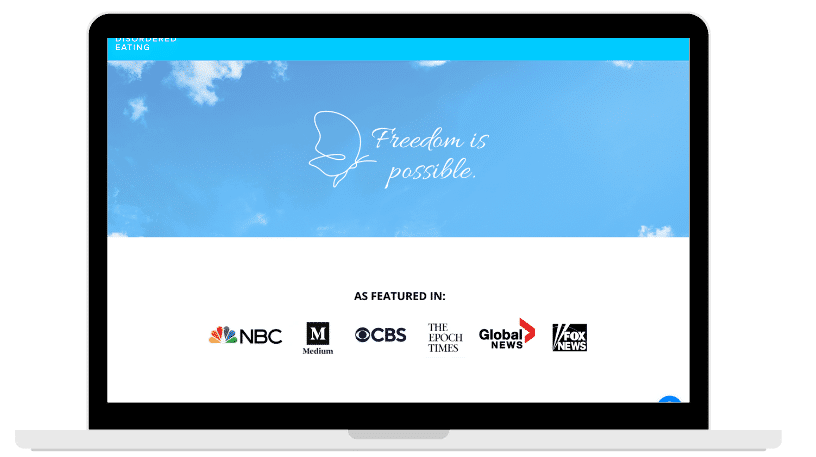
As you can see, it doesn’t look powerful or compelling. It looks like a generic brand. So we redesigned her brand and upgraded her message and this is what the brand looks like now:
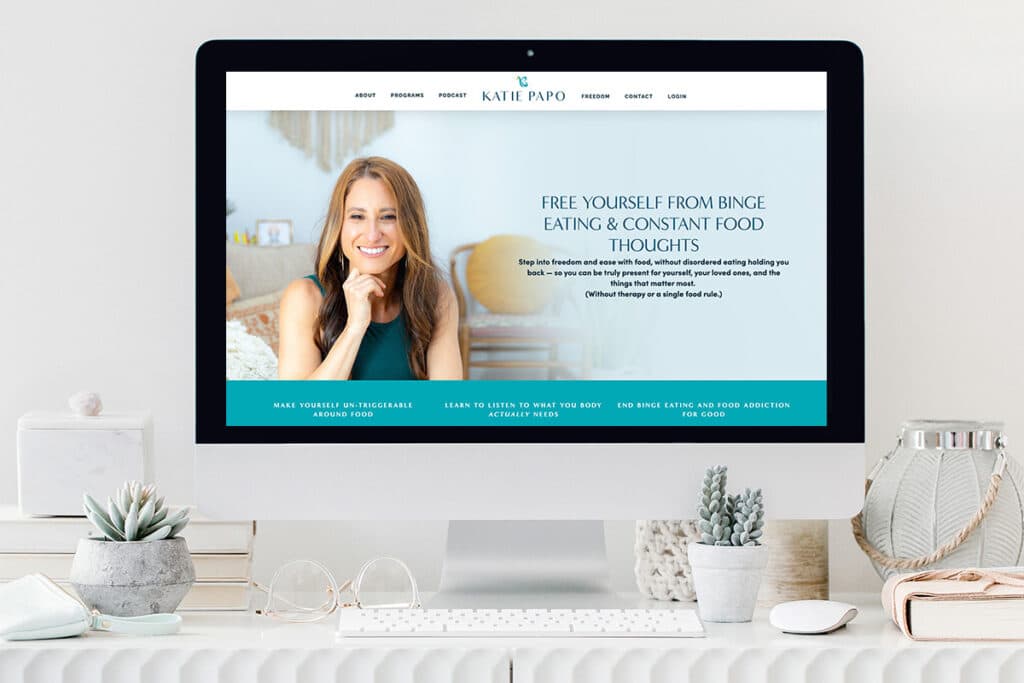
Make it easy to sign up
Your sales page should make it easy for potential clients to sign up for your coaching program. Include a clear call-to-action and a simple sign-up process that is easy to complete.
By creating a sales page that clearly communicates the benefits of your coaching program, uses persuasive language, includes social proof, uses compelling visuals, and makes it easy to sign up, you can increase the conversion rate and attract more high-paying clients to your coaching business.
Step 6: Market and Promote Your Coaching Program Effectively
Once you have created your high-ticket coaching program and compelling sales page, it’s time to start promoting your program and attracting potential clients. Here are some effective marketing strategies you can use:
Social Media Marketing
Social media is a powerful tool to promote your coaching program. Identify the social media platforms where your target audience is most active and create a strong presence on those platforms. Use a mix of organic and paid social media strategies to reach potential clients and drive traffic to your page.
Email Marketing
Build an email list of potential clients who have expressed interest in your coaching program or have engaged with your content in the past. Use email marketing to keep your audience engaged and informed about your program. Offer valuable content, tips, and resources to build trust and credibility with your audience.
Check out this blog post to find out 4 Reasons why building an email list will bring you clients.
Webinars
Host webinars to educate your target audience about your coaching program and how it can help them achieve their goals. Use webinars to offer a taste of your coaching style and provide valuable insights on topics related to your niche.
Here’s an example of a webinar I created and use in my own business

Referral Marketing
Encourage your satisfied clients to refer their friends and family to your coaching program. Offer incentives such as discounts or free coaching sessions to clients who refer new clients to your program.
Partnerships and Collaborations
Partner with other coaches, consultants, or businesses that serve a similar target audience and offer complementary services. Collaborate on joint webinars, workshops, or events to reach a wider audience and create valuable content for your target audience.
Paid Advertising
Consider using paid advertising platforms such as Google Ads or Facebook Ads to reach your target audience and drive traffic to your sales page. Be sure to target your ads to the specific audience that is most likely to be interested in your program.
Remember to track your marketing efforts and analyze which strategies are most effective in generating leads and sales. Continuously refine and optimize your marketing strategy to improve your results over time.
By following these steps, you can create a high-ticket coaching program that meets the specific needs of your target audience, positions you as an expert in your field, and helps you build a successful and sustainable coaching business.
If you want to Upgrade Your Marketing to attract more Ready to Invest Clients, check out this super valuable blog post.
How to Convince Potential Clients to Invest in Your High Ticket Coaching Program
When selling a high-ticket coaching program, it’s important to anticipate and address common objections that potential clients may have. You want to do this through the content you create and your message as a brand. Here are a few objections that you may encounter and strategies to overcome them:
“I can’t afford it”
This is a common objection to high-ticket coaching programs. One strategy to overcome this objection is to emphasize the value that the program provides. Highlight the benefits that the client will receive by working with you, such as personalized attention, direct access to your expertise, and a customized program that addresses their specific needs. You can also offer flexible payment plans that make the investment more manageable.
You also want to learn to speak more to the ready-to-invest people in order to overcome this common objection.
“I’m not ready”
Some potential clients may feel that they’re not ready for a high-ticket coaching program. Either because they’re new to coaching or because they don’t feel confident in their ability to commit to the program.
To overcome this objection, emphasize the benefits of investing in themselves and their growth. Highlight the success stories of your previous clients and how your program can help them achieve similar results.
“I don’t have the time”
Time constraints can be a significant barrier for potential clients, particularly those who are busy professionals or have other commitments.
To overcome this objection, emphasize the flexibility of your program. Highlight that your coaching is tailored to their schedule and can be done remotely or in person and that the program can be adapted to fit their needs and lifestyle.
“I don’t see the value”
Some potential clients may not fully understand the value of investing in a high-ticket coaching program.
To overcome this objection, emphasize the long-term benefits of the program. Highlight that the investment is an investment in themselves and their future success. Emphasize the potential for higher levels of success, more significant impact, and a better quality of life.
This is the importance of having a powerful brand message that is able to effectively articulate the value you deliver.
“I’ve tried coaching before, and it didn’t work for me”
This objection often arises from potential clients who have had negative experiences with coaching in the past or have heard negative things about coaching from others.
To overcome this objection, emphasize how your coaching program is different from what they’ve experienced before. Highlight your unique coaching methodology and framework that sets you apart from other coaches and helps clients achieve better results. You can also offer a satisfaction guarantee to alleviate any concerns they may have about investing in the program.
“I’m not sure if we’re a good fit”
Some potential clients may be unsure if your coaching program is right for them. To overcome this objection, offer a free consultation or discovery call to assess their needs and goals. During the call, you can address any concerns they have and explain how your program can help them achieve their goals.
This also helps to determine if they are a good fit for you as well.
“I’m too busy right now”
Similar to the “I don’t have the time” objection, this objection is often rooted in concerns about time constraints. To overcome this objection, emphasize the importance of investing time in themselves and their future success. Highlight the potential for significant improvements in their personal and professional life by committing to your coaching program. You can also emphasize the time-saving benefits of working with a coach who can help them achieve their goals more efficiently and effectively.
“I’m not sure if I’m ready for such a significant commitment”
Some potential clients may feel hesitant about committing to a high-ticket coaching program for an extended period.
To overcome this objection, offer a trial period or shorter coaching package to give them a taste of what your program can offer. You can also emphasize the long-term benefits of investing in themselves. As well as their future success and highlight the potential for significant improvements in their personal and professional life.
By anticipating and addressing these common objections, you can help potential clients see the value in investing in a high-ticket coaching program and overcome any barriers to making the investment.
Revolutionize Your Coaching Business with High Ticket Programs: Final Thoughts and Actionable Tips
Creating a high-ticket coaching program is a powerful way for coaches and consultants to attract high-paying clients, generate significant revenue, and have a greater impact on their client’s lives.
By following the steps outlined in this article, coaches can:
- Identify their target audience,
- Develop a coaching methodology,
- Price their program appropriately,
- Create a sales page that converts, and
- Effectively market and promote their program.
Investing time and effort in creating a high-ticket coaching program is critical to the success of any coach or consultant looking to grow their business. It may seem daunting at first, but with the right mindset and approach, it is an achievable and worthwhile endeavor.
At the end of the day, the most important thing is to take action and create your own high-ticket coaching program. The potential for success, fulfillment, and financial freedom is within reach. With the right guidance and support, coaches and consultants can achieve their goals and make a lasting impact on their clients’ lives. So don’t wait any longer – take the first step towards creating your own high-ticket coaching program today!
I created a short training that walks you through the 3 secrets to attracting ready-to-invest, premium coaching clients while making weekly, high-ticket sales.
Make sure you check it out below:



